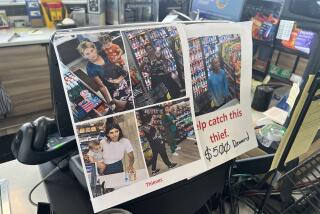Sign Language : There’s a Signpost Up Ahead. Next Stop: a Twilight Zone of Ambiguity, Pictography and Other Posted Peccadilloes
- Share via
IN OUR COSMOPOLITAN society, we seem to be going back to pictographs, instead of words, to give directions and post laws.
Thus we see the walking man, in white light, as a signal that pedestrians may cross a street. Everyone soon learns that a walking man means walk .
Its opposite is a red hand, palm out, which means stop, or don’t walk . Those symbols have replaced the words on many signals.
We have all learned that a diagonal red line over a picture of a cigarette means no smoking ; a silhouette of a woman (identified as such by a skirt) means women’s restroom ; a silhouette of a man means men’s restroom .
There has been a deplorable tendency, especially in cocktail lounges, to use more exotic symbols for the two sexes, or to use foreign words such as damas and hombres .
I’m not sure I understand the need for elementary symbols. Any immigrant surely can learn such basic words as walk or don’t walk in one day, just as I learned that alto means stop in Mexico.
But one of the problems with giving instructions through language is that signs aren’t easy to write, and the shopkeepers and bureaucrats who write them are sometimes especially inept.
Even in England, home of the mother tongue, sign writers sometimes fail to say without ambiguity what they mean. Richard Boston, of the Manchester Guardian, recently complained about signs on public conveyances.
“I thought I was reasonably fluent in my mother tongue,” he wrote, “but my confidence has been shaken by recent experiences.” In London, he said, he boarded a bus and saw a printed notice that said: “Twenty standing passengers allowed on the lower deck unless seats are available.”
He had to read it several times, he said, before knowing what to do. He didn’t say what he concluded.
I have given it some thought, too, and I think it means that if a seat is available, you must take it; you may not stand. If all the seats are taken, then 20 persons only may stand. The others, evidently, must get off the bus.
Boston was also baffled by a sign that said, “Purchase reduced price admission tickets from certain stations when buying your rail tickets to London.”
He finally figured out that the tickets referred to were for an Ideal Home exhibition, but he didn’t know which stations “certain stations” might be.
I have the same problem with commercials advising me that free caps or mugs may be obtained at “participating” gas stations. When I next pass one of those stations, I wonder whether it is participating; I also wonder what’s the matter with the ones that aren’t.
I conclude from signs and ads that the apostrophe is an anachronism, hopelessly misunderstood, and might as well be dropped from the language. I am always passing a house with a sign out front that says The Smith’s or The Jones’ or something similarly illiterate.
As Robert Pattison argues in “On Literacy,” “Only Americans over 40 or those educated in the select few schools that propagate the most exact habits still employ apostrophes with habitual conformity to the established rules.”
(Pattison’s whole book is a denunciation of correct usage, which he considers elitist, capitalistic and decadent; oddly, though, his own prose conforms to the rules he deplores.)
Any traveler knows the humor that can result when foreigners try to make signs in English. Their efforts show how complex, elusive and wonderful English can be.
Many examples are collected by Nino Lo Bello in “English Well Speeched Here,” a copy of which has been sent to me by Ann Wells of the Orange Coast Daily Pilot.
Setting the tone are two signs found in a Majorca shop: “English Well Talking” and “Here Speeching American.”
Around the world Lo Bello found signs equally well-talked. A sign in a Florence shop window advertised, “Dresses for Street Walking.” The following ad was placed in the Cyprus Mail: “Wanted, part-time receptionist and telephone operator (Small broad).”
In Istanbul, a dentist advertised: “American Dentist, 2nd Floor. Teeth Extracted by Latest Methodists.”
A card on the concierge’s desk in a Sorrento hotel advised guests: “Contact the concierge immediately for information. Please don’t wait last minutes then it will be too late to arrange any inconveniences.”
The author betrays his own problem with apostrophes in his introduction to another sign: “The sign at the concierge’s desk in an Athen’s hotel reads . . . .”
A sign to challenge any romantic was found in a Zurich hotel: “Because of the impropriety of entertaining guests of the opposite sex in the bedroom, it is suggested that the lobby be used for this purpose.”
And a Rome laundry suggested: “Ladies, leave your clothes here and spend the afternoon having a good time.”
My favorite sign is in perfect English, but with the disappearance of the passenger train, it is already an anachronism itself:
“Passengers must please refrain from flushing toilets while the train is standing in the station.”
That’s almost perfect trochaic tetrameter.






